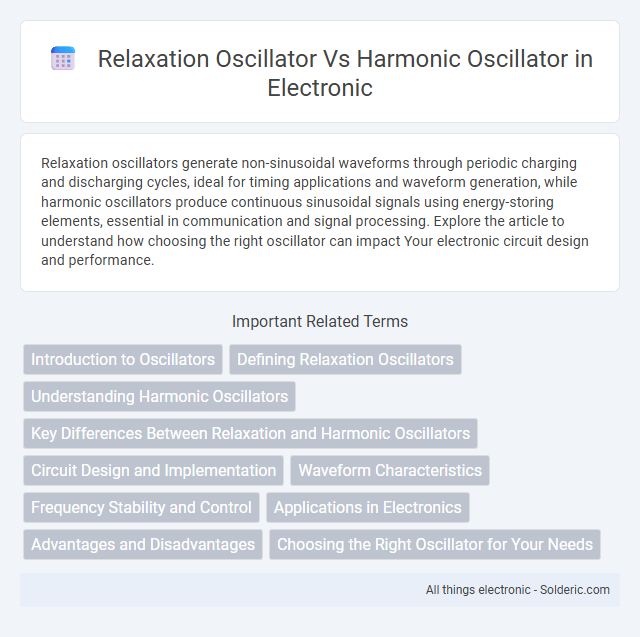Relaxation oscillators generate non-sinusoidal waveforms through periodic charging and discharging cycles, ideal for timing applications and waveform generation, while harmonic oscillators produce continuous sinusoidal signals using energy-storing elements, essential in communication and signal processing. Explore the article to understand how choosing the right oscillator can impact Your electronic circuit design and performance.
Comparison Table
| Feature | Relaxation Oscillator | Harmonic Oscillator |
|---|---|---|
| Oscillation Type | Non-sinusoidal, periodic | Sinusoidal, smooth |
| Energy Storage | Charges and discharges energy in capacitors or inductors | Continuous energy exchange between kinetic and potential forms |
| Frequency Stability | Lower, depends on charging time constants | Higher, determined by system parameters |
| Waveform Output | Square, sawtooth, or pulse waves | Sine waves |
| Examples | Multivibrator circuits, flashing lights | Mass-spring systems, LC circuits |
| Applications | Timer circuits, pulse generation | Signal generation, filters, clocks |
Introduction to Oscillators
Relaxation oscillators generate non-sinusoidal waveforms like square or sawtooth waves through charging and discharging cycles of capacitors or inductors, making them ideal for timing applications. Harmonic oscillators produce sinusoidal waves by relying on resonant circuits that maintain a steady amplitude and frequency, commonly used in signal generation and filtering. Understanding these fundamental differences helps you select the appropriate oscillator type based on waveform shape and application requirements.
Defining Relaxation Oscillators
Relaxation oscillators generate non-sinusoidal waveforms like square or sawtooth waves by charging and discharging energy storage elements such as capacitors through nonlinear components. Unlike harmonic oscillators that produce sinusoidal signals based on linear resonance at a natural frequency, relaxation oscillators rely on threshold-based switching to create periodic signals. Your choice between these depends on whether a simple, robust switching waveform or a pure sinusoidal output is required for the application.
Understanding Harmonic Oscillators
Harmonic oscillators generate smooth, sinusoidal waveforms characterized by a restoring force proportional to displacement, fundamental in systems like pendulums and LC circuits. Your understanding of harmonic oscillators involves recognizing their predictable, periodic motion and energy exchange between kinetic and potential forms. Unlike relaxation oscillators, which produce non-sinusoidal waveforms with abrupt transitions, harmonic oscillators maintain continuous, stable oscillations crucial for signal processing and timekeeping applications.
Key Differences Between Relaxation and Harmonic Oscillators
Relaxation oscillators generate non-sinusoidal waveforms through periodic charging and discharging processes, resulting in abrupt transitions, whereas harmonic oscillators produce smooth, sinusoidal oscillations based on continuous energy exchange between inductive and capacitive elements. The frequency of a relaxation oscillator depends primarily on charging time constants, making it highly adjustable, while harmonic oscillators rely on resonant frequency determined by fixed inductance and capacitance values, providing stable and precise oscillations. Your choice between these oscillator types hinges on the desired waveform shape, frequency stability, and application requirements such as timing circuits or signal generation.
Circuit Design and Implementation
Relaxation oscillators use nonlinear components such as comparators or Schmitt triggers to generate periodic waveforms through charge and discharge cycles, making their circuit design simpler and suitable for generating non-sinusoidal signals like square or sawtooth waves. Harmonic oscillators rely on linear reactive components like inductors and capacitors or quartz crystals to produce continuous sinusoidal waveforms, which requires precise tuning of resonance frequencies and often more complex circuit topologies. Your choice between these oscillators depends on the desired waveform, frequency stability, and implementation complexity in your specific electronic application.
Waveform Characteristics
Relaxation oscillators generate non-sinusoidal waveforms such as square, sawtooth, or triangular waves, characterized by abrupt transitions and variable frequency determined by the charging and discharging of capacitors. Harmonic oscillators produce smooth, continuous sinusoidal waveforms with a constant frequency that depends on the resonant frequency of the inductive and capacitive (LC) components or crystal elements. The sharp wavefronts of relaxation oscillators contrast with the pure tone and steady amplitude of harmonic oscillators, making each suitable for different signal processing applications.
Frequency Stability and Control
Relaxation oscillators exhibit lower frequency stability due to their dependence on nonlinear components and charge-discharge cycles, resulting in wider frequency variations with changes in temperature and supply voltage. Harmonic oscillators provide superior frequency stability and precise control through linear reactive components like inductors and capacitors, enabling consistent sinusoidal outputs with minimal frequency drift. The frequency of harmonic oscillators can be finely tuned via variable capacitors or inductors, whereas relaxation oscillator frequency control often relies on modulating RC time constants or switching thresholds, limiting its accuracy.
Applications in Electronics
Relaxation oscillators are widely used in electronic timing circuits, pulse generation, and waveform shaping due to their simple design and ability to produce non-sinusoidal waveforms such as square or sawtooth waves. Harmonic oscillators are essential in signal generation, clock circuits, and RF communication systems where stable sinusoidal waveforms with precise frequency control are required. The choice between relaxation and harmonic oscillators depends on the specific application's frequency stability, waveform shape, and complexity requirements.
Advantages and Disadvantages
Relaxation oscillators offer simple design and generate non-sinusoidal waveforms like square or sawtooth waves, making them ideal for timing and pulse applications but suffer from lower frequency stability and higher harmonic distortion compared to harmonic oscillators. Harmonic oscillators provide high frequency stability and produce pure sinusoidal signals suited for communication systems and signal processing, yet they require more complex circuitry and precise component values. Choosing between the two depends on the application's need for waveform purity versus design simplicity and stability requirements.
Choosing the Right Oscillator for Your Needs
Relaxation oscillators generate non-sinusoidal waveforms like square or sawtooth waves, making them ideal for timing circuits, pulse generation, and switching applications. Harmonic oscillators produce smooth sinusoidal signals suited for RF communication, signal processing, and applications requiring stable frequency output. Selecting the right oscillator depends on whether the application demands precise frequency stability and purity (harmonic oscillator) or simple waveform generation and switching capabilities (relaxation oscillator).
Relaxation oscillator vs Harmonic oscillator Infographic

 solderic.com
solderic.com